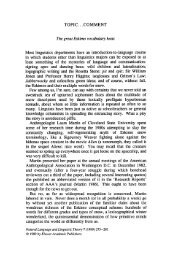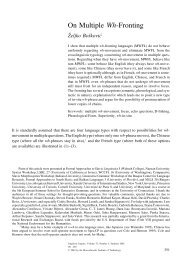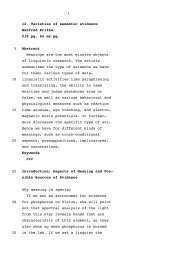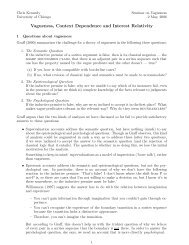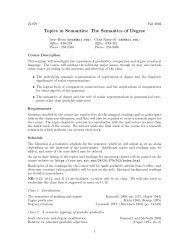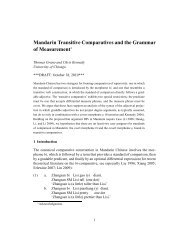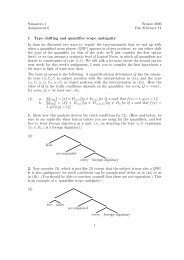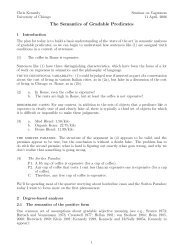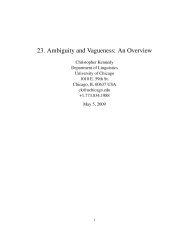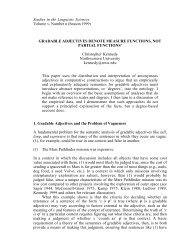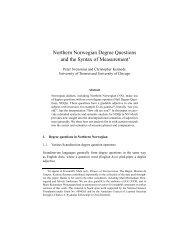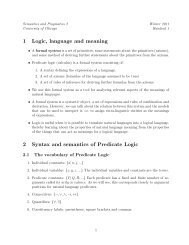On the natural history of negative polarity items - Syntax, Semantics ...
On the natural history of negative polarity items - Syntax, Semantics ...
On the natural history of negative polarity items - Syntax, Semantics ...
You also want an ePaper? Increase the reach of your titles
YUMPU automatically turns print PDFs into web optimized ePapers that Google loves.
Judith Tonhauser<br />
(3) (In a context where Julia is <strong>the</strong> only salient third person.)<br />
#Júlia mbo’ehára ha ha’é=katu chokokue (avei).<br />
Julia teacher and she=contrast farmer too<br />
(Intended: Julia is a teacher and she is a farmer (too).)<br />
[acceptable without =katu]<br />
(4) Context: Maria runs into Celina in <strong>the</strong> supermarket and says:<br />
#Ché=katu a-joguá-ta kamby!<br />
[acceptable without =katu]<br />
I=contrast 1sg-buy-going.to milk<br />
(Intended: I am going to buy milk.)<br />
Formal pragmatic analysis The contribution <strong>of</strong> =katu to <strong>the</strong> meaning <strong>of</strong> an utterance is given<br />
in (5). Crucially, (5) does not assume that <strong>the</strong> contrastive topic <strong>of</strong> <strong>the</strong> utterance is identified<br />
prosodically, morphologically or syntactically.<br />
(5) An utterance U containing =katu is felicitous only if U is part <strong>of</strong> a (possibly implicit)<br />
contrastive topic strategy.<br />
The contrastive topic strategy, defined in (6), makes use <strong>of</strong> <strong>the</strong> contrastive semantic value [[U]] CT ,<br />
defined in (7) and adapted from Büring’s work, which in turn builds on Rooth’s (1992) focus<br />
semantic value [[U]] f .<br />
(6) An assertion U in discourse D is part <strong>of</strong> a contrastive topic strategy iff<br />
a. The question move M1 that immediately dominates U has a non-empty set <strong>of</strong> distinct<br />
sister question moves {M2,...,Mi}.<br />
b. There is an question move M ′ that immediately dominates <strong>the</strong> moves M1, M2,...,Mi.<br />
c. There exists a [[U]] CT such that for every M in {M1, M2,...,Mi}, [[M]]∈ [[U]] CT .<br />
(7) A contrastive topic semantic value [[U]] CT <strong>of</strong> utterance U is a set <strong>of</strong> sets <strong>of</strong> propositions<br />
obtained by first abstracting over (part <strong>of</strong>) <strong>the</strong> <strong>the</strong>me <strong>of</strong> U (to create a set <strong>of</strong> propositions<br />
{U1, U2,...,Un}, and<strong>the</strong>ncreating<strong>the</strong>focussemanticvalue[[Ui]] f for each Ui (1 ≤ i ≤ n).<br />
The analysis correctly predicts that example (1) is acceptable: assuming <strong>the</strong> QUD for U is M1<br />
‘What did Sambo eat?’, a set <strong>of</strong> sister question moves can be plausibly accommodated (per (6a),<br />
e.g. M2 ‘What did Sambo’s fa<strong>the</strong>r eat?’, Mi ‘What did Sambo’s mo<strong>the</strong>r eat?’), as well as a mo<strong>the</strong>r<br />
question move (per (6b), e.g. M ′ ‘Who ate what?’). Following Hamblin (1973), <strong>the</strong> meaning <strong>of</strong><br />
aquestionisaset<strong>of</strong>possibleanswers. Then,per(6c),wecanobtaina[[U]] CT by abstracting<br />
over Sambo (which is part <strong>of</strong> <strong>the</strong> <strong>the</strong>me <strong>of</strong> U) and 35 mbeju (<strong>the</strong> focus), such that for every M<br />
in {M1, M2, Mi}, [[M]]∈ [[U]] CT ,namely[[U]] CT = {{Sambo ate 54 mbeju, Sambo ate cassava<br />
root, Sambo ate a chicken leg...}, {Sambo’s fa<strong>the</strong>r ate 35 mbeju, Sambo’s fa<strong>the</strong>r ate cassava root,<br />
Sambo’s fa<strong>the</strong>r ate a chicken leg,...}, {Sambo’s mo<strong>the</strong>r ate 20 mbeju, Sambo’s mo<strong>the</strong>r ate cassava<br />
root, Sambo’s mo<strong>the</strong>r ate a chicken leg,...}, ...}. Examples (3) and (4), on<strong>the</strong>o<strong>the</strong>rhand,are<br />
correctly predicted to be unacceptable since <strong>the</strong>y fail (6c) and (6a), respectively.<br />
As in o<strong>the</strong>r languages, <strong>the</strong> contrastive topic strategy can be largely implicit in Guaraní, as<br />
in example (1). Evidence that =katu presupposes a contrastive strategy, as given in (5), comes<br />
from elicited discourses in which <strong>the</strong> question moves are all or mostly explicit, as well as utterances<br />
where =katu occurs under <strong>the</strong> scope <strong>of</strong> a modal, in <strong>the</strong> antecedent <strong>of</strong> a conditional or <strong>the</strong><br />
complement <strong>of</strong> a propositional attitude verb like –mo’ã ‘think/believe’.<br />
Implications: Guaraní =katu is a contrastive topic marker but differs from o<strong>the</strong>r such markers<br />
in e.g. not presupposing <strong>the</strong> adversative/<strong>polarity</strong> implication. The proposed pragmatic analysis<br />
extends <strong>the</strong> formal treatment <strong>of</strong> contrastive topics to Guaraní, a language under-represented in<br />
semantic/pragmatic research, and allows for a cross-linguistic comparison <strong>of</strong> contrastive topics.<br />
2



